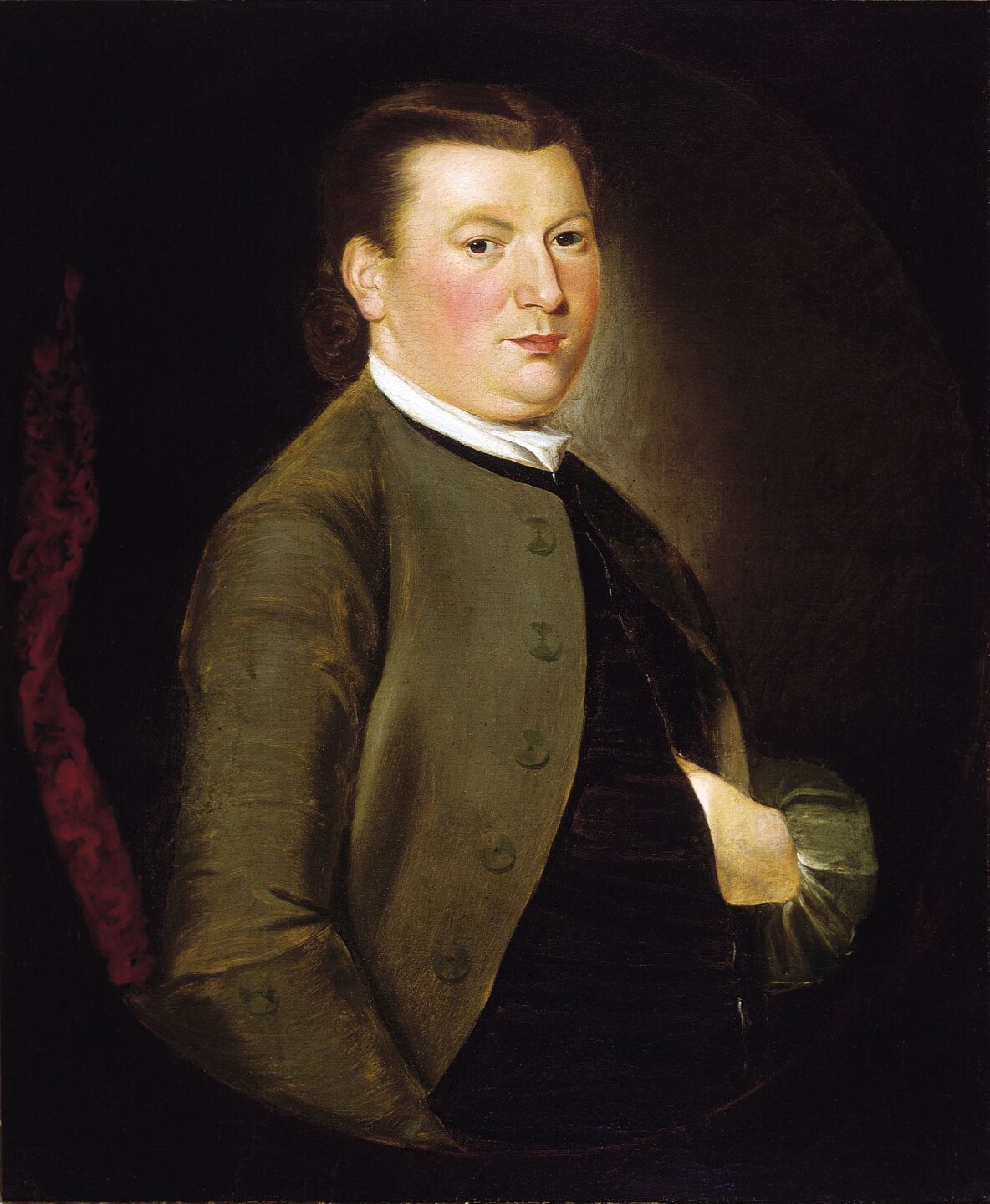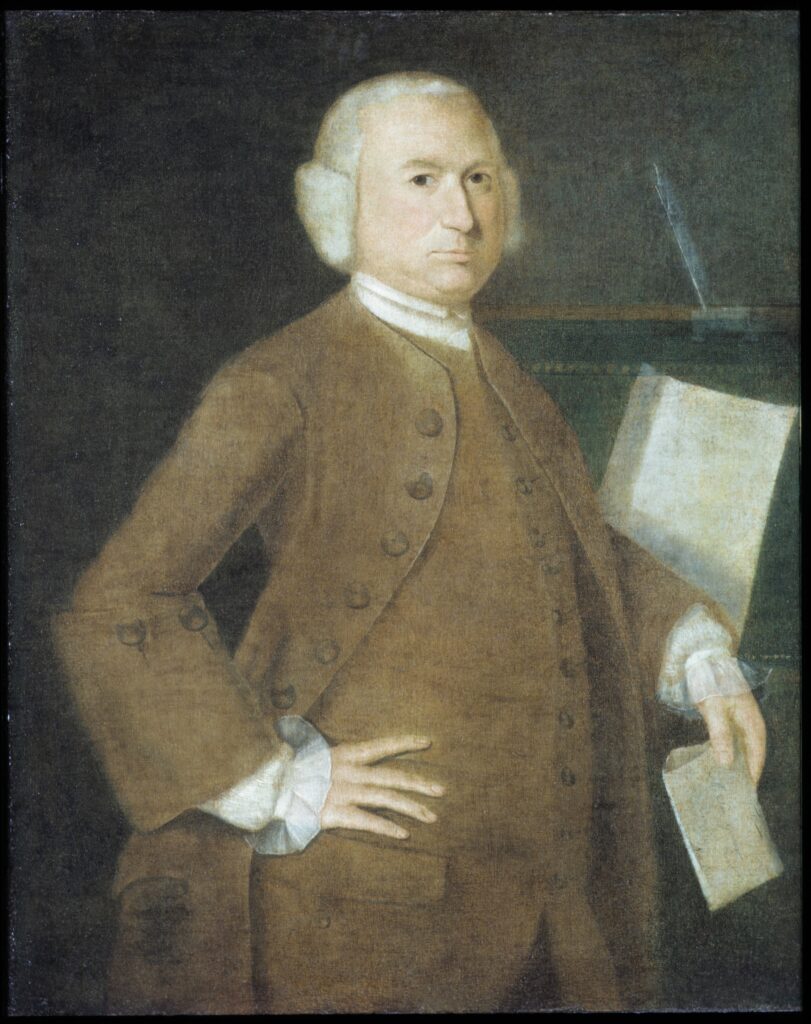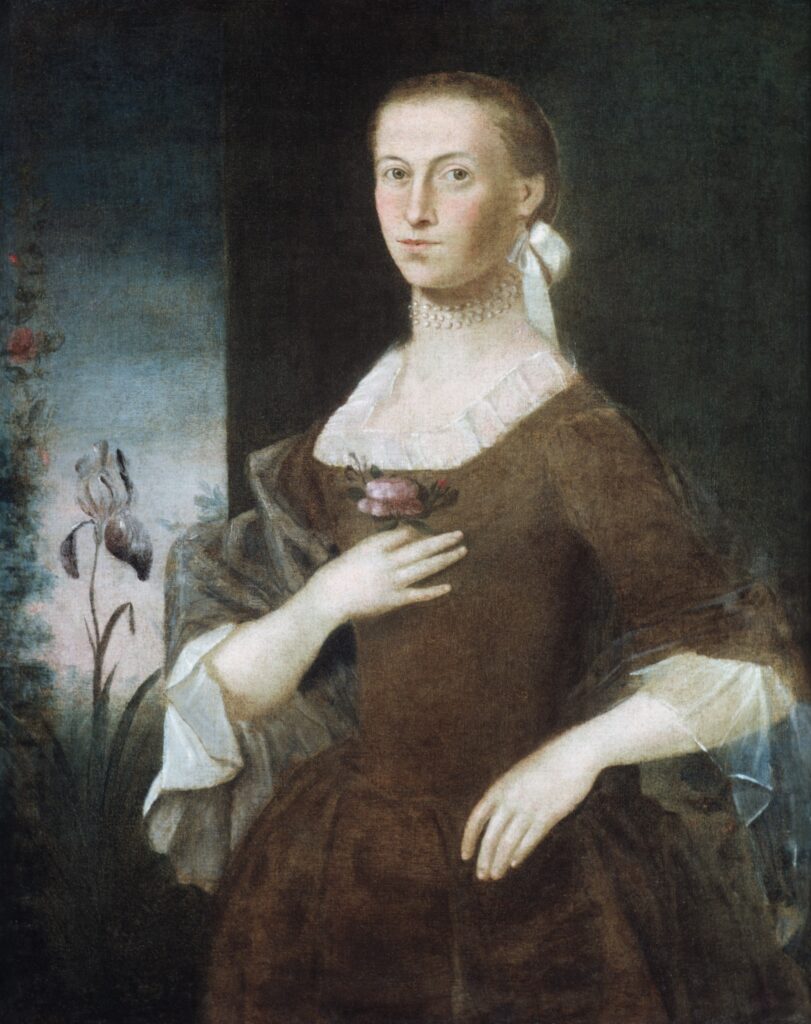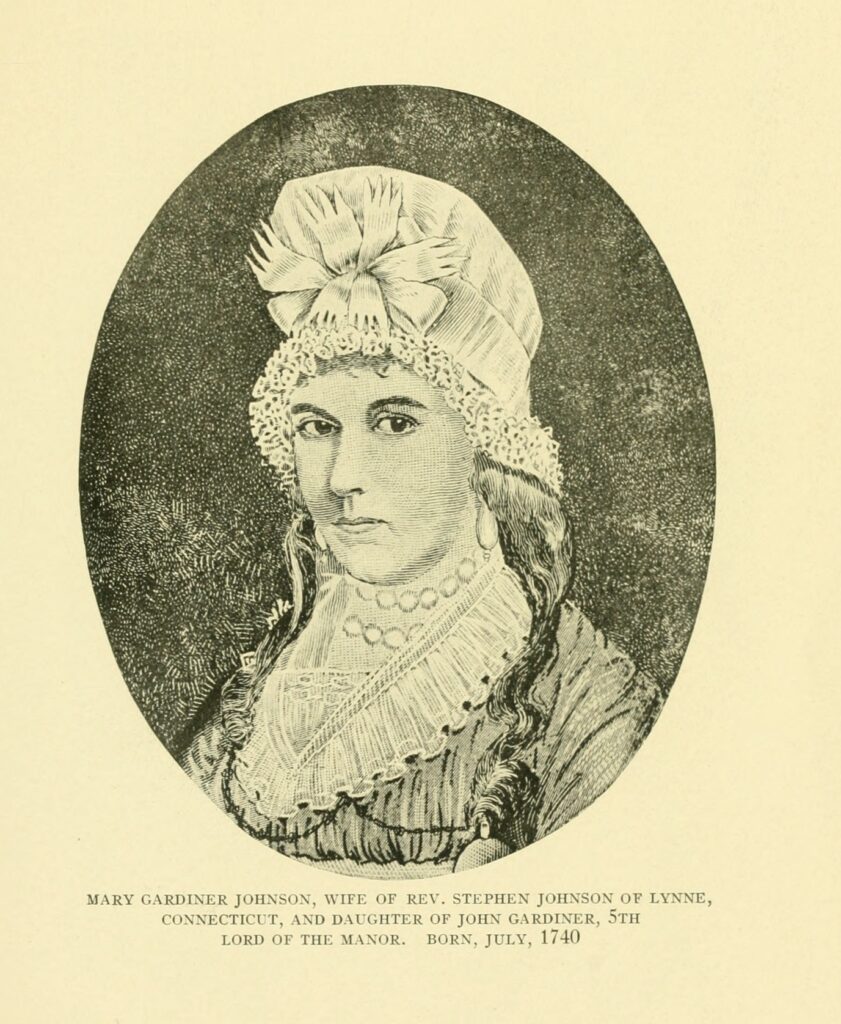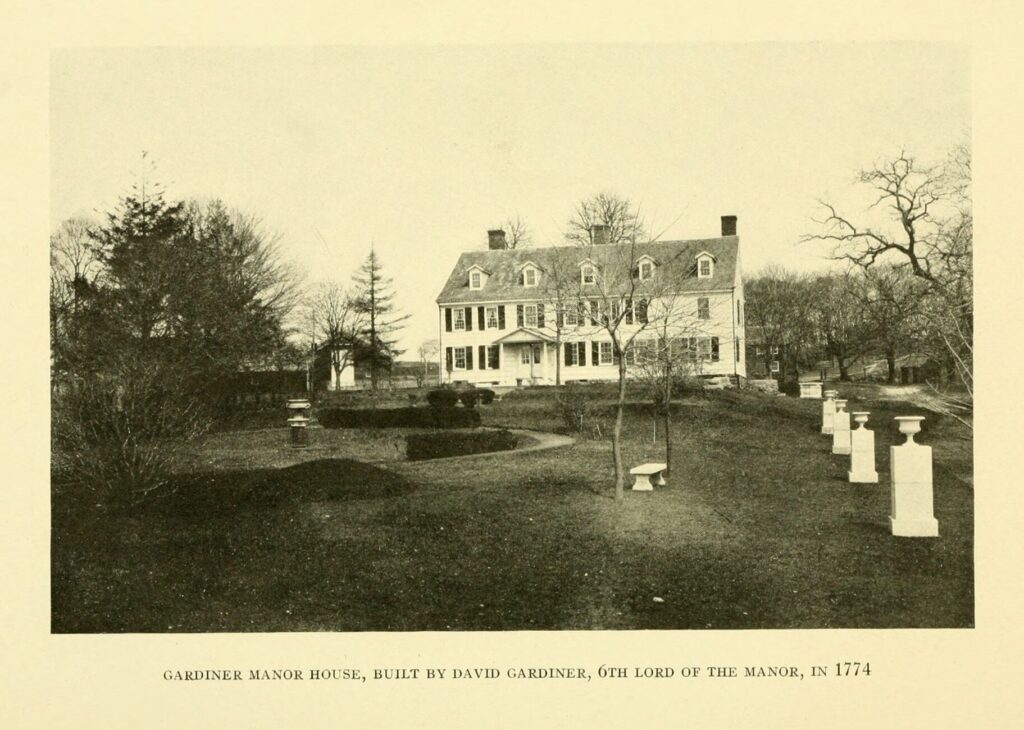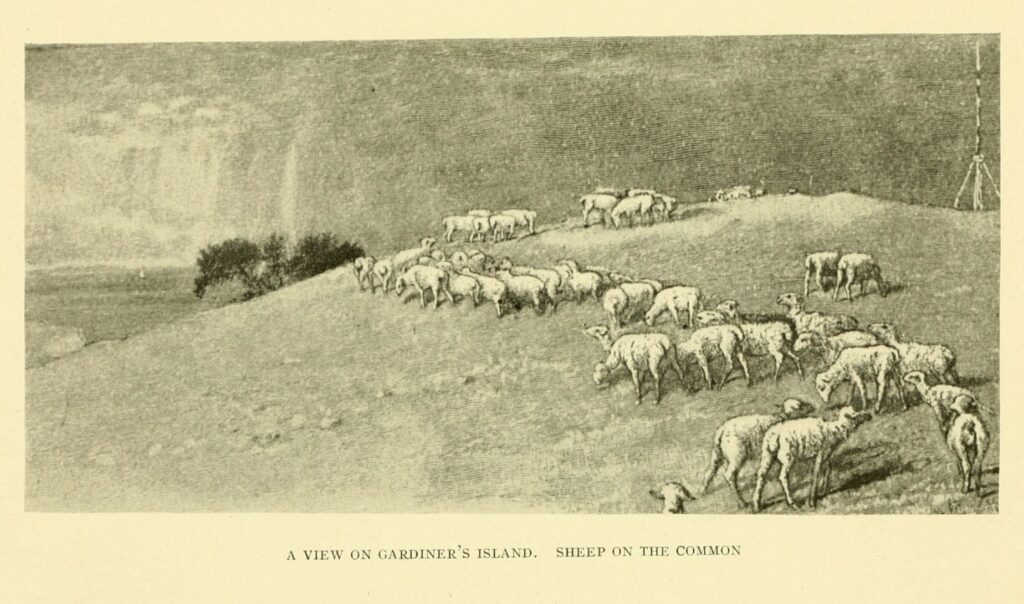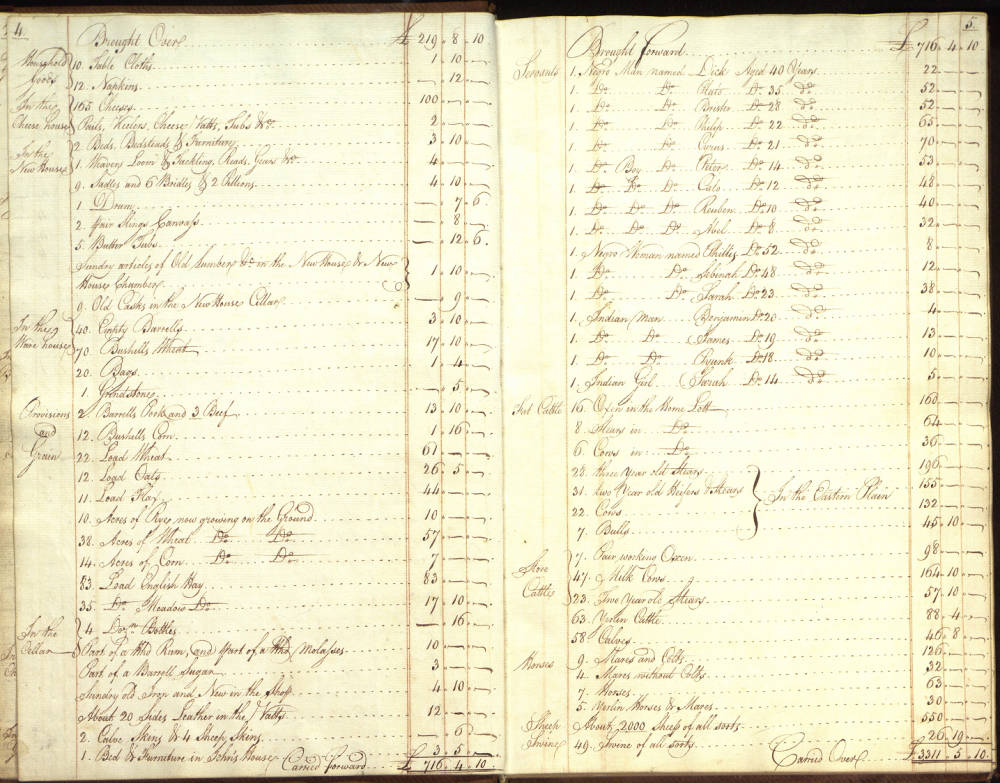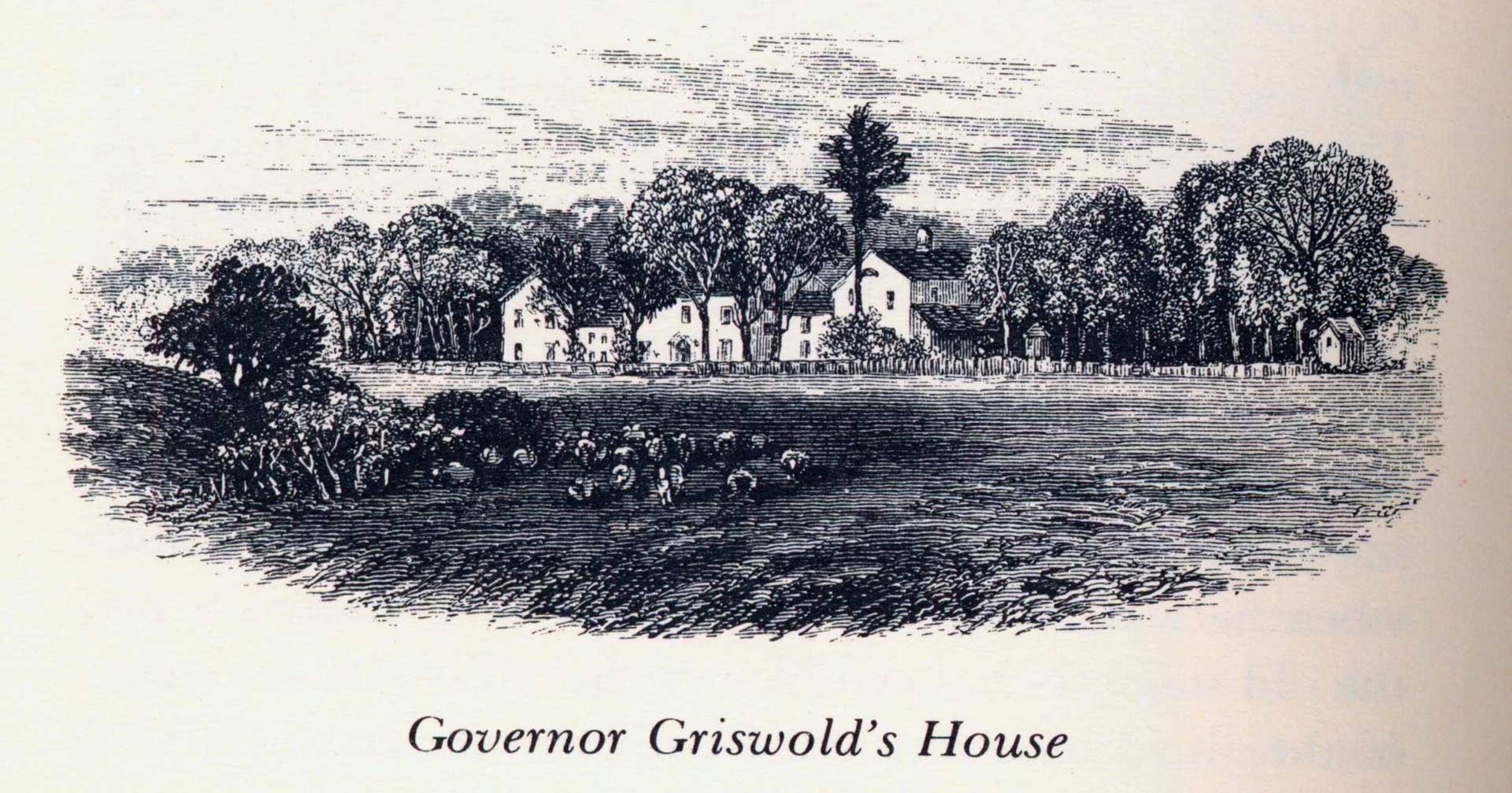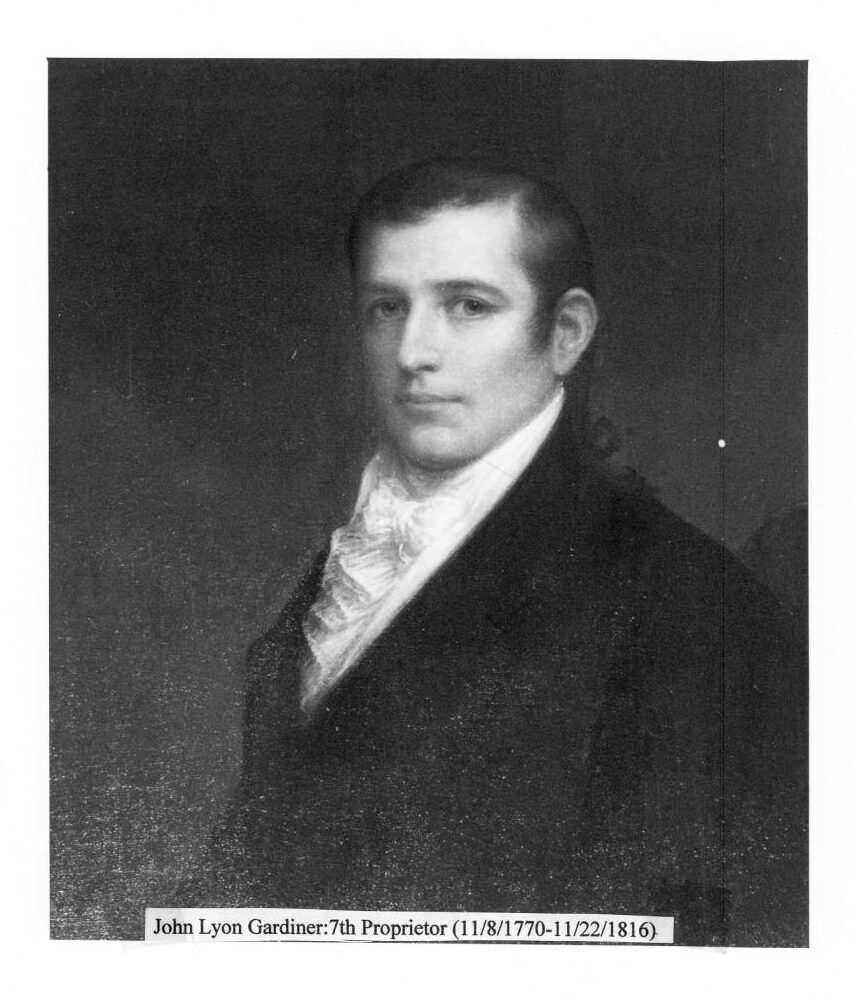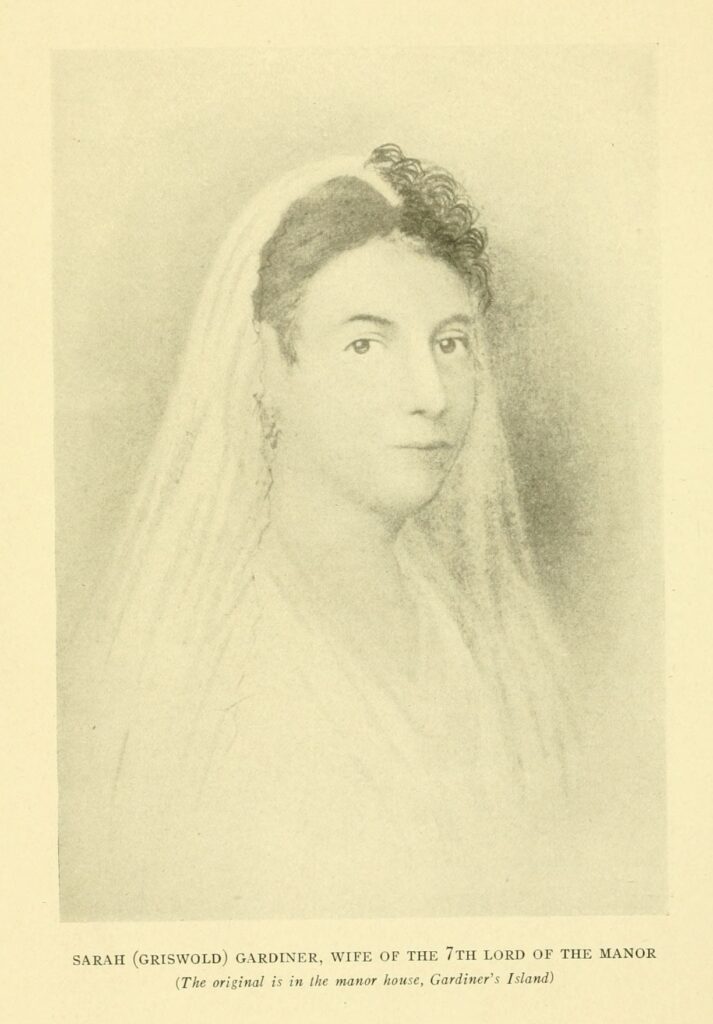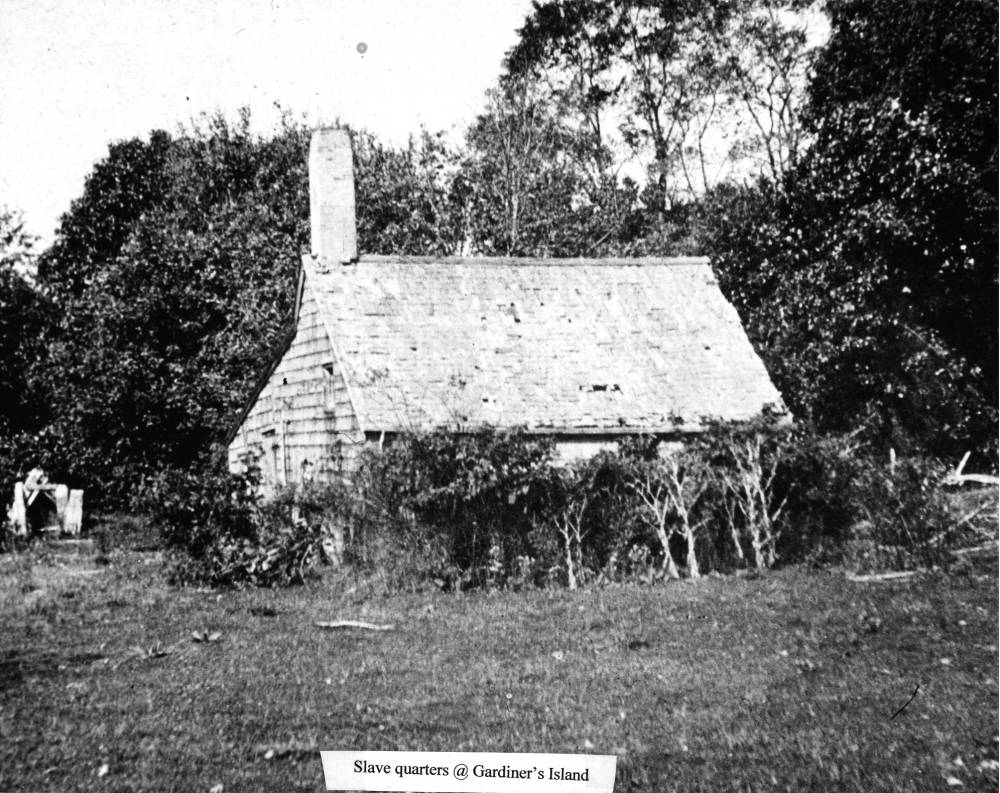
Unseen in the portrait of David Gardiner are the enslaved African Americans and Native Americans who labored on his Gardiner’s Island estate and sustained the inherited wealth of his family.
By Carolyn Wakeman
Featured Image: William Johnston (1732-1772), David Gardiner, Jr. (detail), ca. 1762-1763. Oil on canvas. Florence Griswold Museum, Gift of The Hartford Steam Boiler Inspection and Insurance Company, 2002.1.75
A handsome portrait of David Gardiner (1738–1774), age 24, introduces a visitor to the Florence Griswold Museum’s 2021 exhibition Expanding Horizons: Celebrating 20 Years of the Hartford Steam Boiler Collection. The itinerant artist William Johnston (1732–1772) painted the young David Gardiner, a recent Yale graduate, most likely in New London in 1763. His serious gaze, robust complexion, and unpretentious attire convey comfort, health, and ease with his role and his circumstances. Raised on his family’s hereditary estate on Gardiner’s Island and accustomed to the wealth of New England’s landed gentry, David Gardiner would soon inherit the title of sixth lord of the manor. His father John Gardiner (1714–1764), the fifth proprietor, had already written a will that bestowed ownership of the island on his oldest son.[1]
William Johnston (1732-1772), David Gardiner, Jr., ca. 1762-1763. Oil on canvas. Florence Griswold Museum, Gift of The Hartford Steam Boiler Inspection and Insurance Company, 2002.1.75
The estate had descended in the family since Lion Gardiner (1599–1663) acquired from the Montaukett tribe the island that he named Isle of Wight. The English military engineer had agreed in 1635 to build a settlement at the mouth of the Connecticut River for notables intending to emigrate. He constructed a fort at Saybrook that would defend English trading rights and claims to tribal land, but the “gentlemen of quality” never arrived. After the Pequot War when his four-year contract concluded, Gardiner removed permanently to the 3,300-acre island sixteen miles offshore from Saybrook.[2]
The Gardiner descendant who sat for William Johnston in 1763 had stopped in New London to visit relatives after a horseback tour of New England. The plantation he would soon inherit produced livestock and a wide range of agricultural products for markets in New York, Boston, and the West Indies, and he likely had commercial arrangements with his uncle Samuel Gardiner (1724–1776), a successful New London merchant. The diary in which David Gardiner recorded details about his travel mentions that he also saw a cousin named David “just returned from sea.”[3] That same year Samuel Gardiner and his wife, along with other local merchants like Jacob Hurd, commissioned portraits by William Johnston.
William Johnston (1732-1772), Samuel Gardiner, 1763. Oil on canvas. The Metropolitan Museum of Art, Gift of Edgar William and Bernice Chrysler Garbisch, 1970.283.2
William Johnston (1732-1772), Mrs. Samuel Gardiner, 1763, Oil on canvas. The Metropolitan Museum of Art, Gift of Edgar William and Bernice Chrysler Garbisch, 1970.283.3
While in Connecticut, David Gardiner called on his younger sister Mary Gardiner Blague Johnson (1740–1772), who had recently settled in Lyme. Following the death of her first husband, she married in December 1762 the town’s widowed minister Stephen Johnson (1724–1786) and became step-mother to his two children. Rev. Johnson would soon denounce Britain’s enslavement of its American colonies in a series of letters published in 1765 in the New London Gazette that brought him recognition as a courageous and outspoken patriot. When David visited his sister, the minister had just emerged from an extended legal battle resulting from accusations of adultery. Rev. Johnson had repeatedly denounced those “vile reports” and pursued a defamation suit until 1762 when he married Mary Blague.[4] Her brother’s journal notes only that he found his sister “not well.”[5]
Mary Gardiner Johnston, from The Gardiner Manor: Address Delivered at the Third Annual Meeting of the Order of Colonial Lords of Manors in America, held in the city of New York, April 24, 1915, by Sarah Gardiner Tyler, page 15
The death from apoplexy of their father John Gardiner, age 50, made David lord of the island estate in 1764. Two years later he married the 17-year old daughter of East Hampton’s minister. While supervising the construction of a new manor house in 1774, he died suddenly from consumption at age 36. His will provided for the completion of the new mansion and also named his older son John Lyon Gardiner (1770–1816), age four, as future lord of the manor.
Gardiner Manor House, Built by David Gardiner, 1774, from TThe Gardiner Manor: Address Delivered at the Third Annual Meeting of the Order of Colonial Lords of Manors in America, held in the city of New York, April 24, 1915, by Sarah Gardiner Tyler, page 4
According to a family history, the estate became “a garden of beauty” during the decades before the Revolution. From eighty to one hundred attendants kept it trimmed and blooming, Sarah Diodati Gardiner (1807–1891), the island’s fifteenth proprietor, reported. Some 2,000 loads of hay were stored in its barns every autumn, and three hundred or more cattle grazed in its sunny pastures, along with ten times as many sheep that every year produced thousands of pounds of wool. The manor’s dairy produced quantities of butter and twenty pounds of cheese per day, she wrote, and the lord of the island rarely stabled less than sixty horses, the finest in the country.[6]
A View on Gardiner’s Island. Sheep on the Common, from The Gardiner Manor: Address Delivered at the Third Annual Meeting of the Order of Colonial Lords of Manors in America, held in the city of New York, April 24, 1915, by Sarah Gardiner Tyler, page 18
By then the wealth of Gardiner’s Island had been sustained by enslaved and indentured servants for more than a century. Mary Gardiner (1601–1665), Lion Gardiner’s wife had given her servants Japhet and Boose to her two children, allowing her son to choose “which he will have.” When David Gardiner, the fourth lord of the manor, wrote his will almost a century later in 1751, he gave to his wife Mehetabel “one negro wench as she shall make choice of out of all my slaves.” While the fourth proprietor gave the island, with its goods, chattels, and credits, to his oldest son John Gardiner, he specified that his son Abraham would receive, in addition to land in East Hampton, “one negro slave named Coseo, and also one negro slave named Will.”[7]
David Gardiner’s estate inventory in 1774 documents the sixth proprietor’s personal wealth and confirms the island’s productivity during the pre-Revolutionary decades. The inventory lists first his wearing apparel, then the furnishings in his new house and his old house, the goods in his cheese house, his wine house, his shop, and his cellar, and the crops growing in his fields. Next it itemizes the enslaved and indentured servants who supported his wealth, followed by his livestock, which included “about 2000 sheep of all sorts.” In his will Gardiner left to his beloved wife Jerusha “one Negro woman which she shall chuse,” and his estate inventory shows that she had three options. She could choose Phyllis, the eldest of the enslaved Negro women at age 52, valued at 8 pounds. Or she could choose Sebinah, age 48, valued at 12 pounds, or Sarah, age 23, who at 38 pounds had the highest market value of the three women. The inventory itemized, in addition, five Negro men, four Negro boys, three Indian men, and one Indian girl. The Negro man Cyrus, age 21, at seventy pounds, had the greatest market value of David Gardiner’s servants.[8]
Inventory for the Estate of David Gardiner, deceased, taken September 20, 1774. East Hampton Library, Long Island Collection
His heir John Lyon Gardiner, a Princeton graduate, succeeded to the title of lord of the manor in 1791 and more than a decade later married at age 33 Sarah Griswold (1781–1863) from Lyme. A step-granddaughter of his aunt Mary Blague Johnson and a granddaughter of Connecticut’s former governor Matthew Griswold (1714–1799), Sarah was then 21. The romantic story of the chance beachfront encounter in 1803 that introduced her to the eligible lord of Gardiner’s Island unfolds in a laudatory account of the manor written in 1885 by historian Martha J. Lamb (1829–1893). She describes John Lyon Gardiner as “refined, scholarly, and dwelling in princely solitude on his water-bound manorial estate.”
Mrs. Lamb recounts with some exuberance what transpired after “a party of gay young ladies and gentlemen from Lyme, on the Connecticut shore, while out on a sailing frolic, were suddenly becalmed in the Sound within sight of Gardiner’s Island.” An “old housekeeper graciously received them, and presently the handsome proprietor appeared.” Then “the elegant lord of the manor stepped forth and proceeded to ‘Blackhall,’ the seat of the Griswolds.” Mrs. Lamb had written previously about the prominent Griswold family in a lengthy article about Lyme for Harper’s Magazine in 1876. In her history of the Gardiner’s Island manor, she explains that Sarah Griswold’s father Deacon John Griswold (1752–1812) was the younger brother of Roger Griswold (1762–1812), who became Connecticut’s governor in 1811. She also notes that their two houses “stood side by side overlooking Long Island Sound.”[9]
Attributed to Charles Parsons, Governor Griswold’s House, 1876. Harper’s New Monthly Magazine. Lyme Historical Society Archives, Florence Griswold Museum
The years of Revolution had taken a heavy toll on the “garden of beauty.” After David Gardiner’s death in 1774, British troops plundered the estate repeatedly, ruining outbuildings, destroying fences, cutting timber, and seizing livestock. It took a full quarter of a century, Mrs. Lamb notes, to restore the property to the prosperity it enjoyed before the seven years of war. To restore the island’s productivity and reestablish the manor’s former way of life, John Lyon Gardiner relied primarily on the labor of freed Blacks and indentured native people. In 1800 only four enslaved persons remained on Gardiner’s Island, but some of the estate’s laborers were apparently still considered property in 1816 when he wrote his will, which states: “I give and bequeath to my said Wife all my coloured servants.”[10]
In 1799 David Gardiner’s son and heir listed his transactions with his servants of color in a separate Account Book of Colours or Mulattos. Sarah Diodati Gardiner would comment later that “these trusted Indians and colored servants seem to come to life again through his carefully kept accounts with them.” She lists the names of Ben, Martin, John Cuff, Densie, Sampson, Amos Cuff, Isaac, Plato, Rusus, Nance, John James, Stephen Pharoah, George Pharoah, and John Joe, noting that John Joe seemed to be a favorite. The account book “shows us a fair master,” she states. The ledger confirms that John Joe lived in the house at Great Pond in 1799 and that he had debts in July for 11 pounds of pork, 2 quarts of molasses, half a bushel of wheat, and a pair of shoes. He paid off the debts with his own and his wife’s labor.[11]
John Lyon Gardiner’s Book of Colors together with a second account book covering the years 1801-1806 detail transactions with 33 persons of color, not all of whom had been freed. In 1806 he applied to the Overseers of the Poor of Huntington for approval to emancipate “a certain Negro man Slave named Cato.” The request was approved after the Overseers “examined into the state and Circumstances of Said Slave” and found him to be under fifty years of age and of sufficient ability to provide for himself.”[12] Sarah Diodati Gardiner concludes her comments about the seventh lord of the manor by remarking: “one would like to learn more about those thirteen years in which John Lyon and Sarah lived together on their Island surrounded by their growing family and their contented helpers.”
Unknown Artist, John Lyon Gardiner, 7th Proprietor of Gardiner’s Island. ca. 1790-1816. Springs Historical Society/Library
Sarah Griswold Gardiner, Wife of the 7th Lord of the Manor, from The Gardiner Manor: Address Delivered at the Third Annual Meeting of the Order of Colonial Lords of Manors in America, held in the city of New York, April 24, 1915, by Sarah Gardiner Tyler, page 18
The romanticization of the manor on Gardiner’s Island continues today. A colorful account of the “six-mile long private paradise” that appeared in The Daily Mail in 2019 relies on interviews with Robert Lyon David Gardiner (1911–2004), the last lord of the estate. On a tour for guests, he pointed to an outbuilding where servants had been housed. For many years, he explained, indentured servants tilled the 1,000 aces of fertile land that produced beef, dairy, wool and wheat. “The boys lived there,” he said. “Not black slaves but indentured servants, we gave the child’s parents some money and the child worked off the debt, they lived there.”[13] Whereas Sarah Diodati Gardiner had described the African Americans still enslaved by David Gardiner’s son as “contented helpers,” the last lord of the manor erased black slaves entirely from the island’s history.
Slave Quarters at Gardiner’s Island, Springs Historical Society/Library
[1] John Gardiner, Last Will and Testament, August 30, 1762.
[2] Curtiss C. Gardiner, Lion Gardiner, and His Descendants (St. Louis, 1890), p. 8 ff.; Sarah Gardiner Tyler, The Gardiner Manor: Address Delivered at the Third Annual Meeting of the Order of Colonial Lords of Manors in America (April 24, 1915), pp. 7-8.
[3] Sarah Diodati Gardiner, Early Memories of Gardiner’s Island (East Hampton, 1947), p. 70; Allison Manfra McGovern, Disrupting the Narrative: Labor and Survivance for the Montauketts of Eastern Long Island (PhD dissertation, CUNY, 2015), p. 148.
[4] Carolyn Wakeman, Forgotten Voices: The Hidden History of a New England Meetinghouse (Middletown, 2019), pp. 82-83.
[5] Sarah Diodati Gardiner, p. 70.
[6] Ibid., p. 73.
[7] Curtiss C. Gardiner, pp. 70, 108.
[8] David Gardiner, Last Will and Testament, September 7, 1774.
[9] Martha J. Lamb, “The Manor of Gardiner’s Island,” Magazine of American History, 13 (January 1885), p. 23.
[10] McGovern, p. 146; John Lyon Gardiner, Last Will and Testament, October 29, 1816.
[11] Sarah Diodati Gardiner, p. 80.
[12] Cited in Ric Murphy, Freedom Road: An American Family Saga from Jamestown to World War (Bloomington, 2014), p. 122.
[13] Tate Delloye, “The Colorful History of America’s Oldest Family Estate,” The Daily Mail (April 2, 2019).

